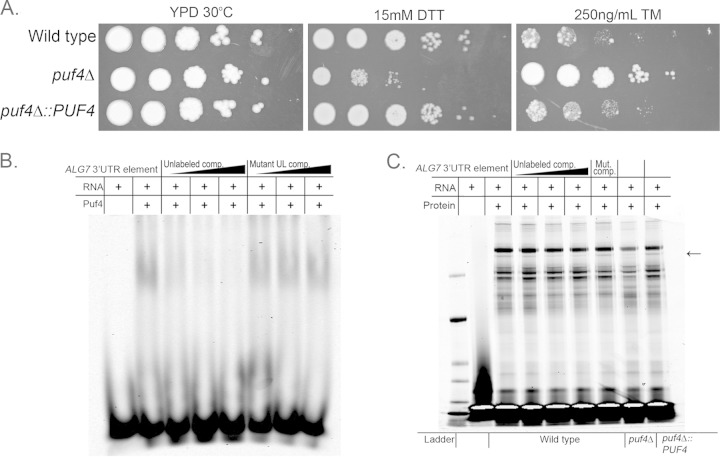FIG 7.
Deletion of PUF4 results in pleiotropic ER stress phenotypes. (A) Serial dilutions of cells on spot plates comparing the growth of the wild-type, puf4Δ, and puf4Δ::PUF4 strains during treatment with DTT or tunicamycin (TM). Cells were spotted onto YPD agar plates containing either 15 mM DTT or 250 ng/ml tunicamycin and then incubated for 3 days and photographed. (B) Native electrophoretic mobility shift assay of the recombinant Puf4 pumilio domain incubated with an RNA oligonucleotide corresponding to a portion of the 3′ UTR of ALG7. Reaction mixtures to which labeled oligonucleotide probe was added are marked with a plus sign in the RNA row. Reaction mixtures to which the pumilio domain of Puf4 was added are indicated by a plus sign in the Puf4 row. Increasing amounts of unlabeled 3′ UTR ALG7 oligonucleotide competitor (Unlabeled comp.) were added to confirm competition. Unlabeled 3′ UTR ALG7 oligonucleotides with a mutated PUF competitor element (Mutant UL comp.) were added to confirm the specificity of the interaction. (C) UV cross-linked SDS-PAGE with the 3′ UTR ALG7 oligonucleotide and whole-cell lysate from the wild-type, puf4Δ, or puf4Δ::PUF4 strain. Arrow, the band that is the size of Puf4. The fourth to sixth lanes contain increasing amounts of the unlabeled 3′ UTR ALG7 oligonucleotide competitor. The seventh lane contains a 50-fold excess unlabeled competitor for the 3′ UTR of ALG7 with the PUF element mutated.

